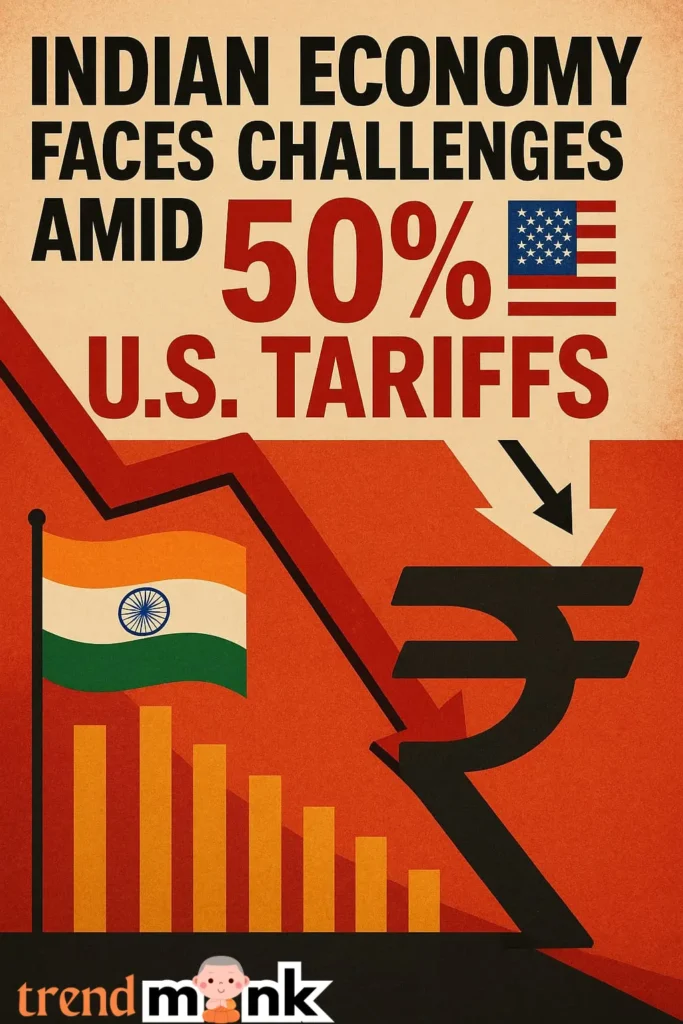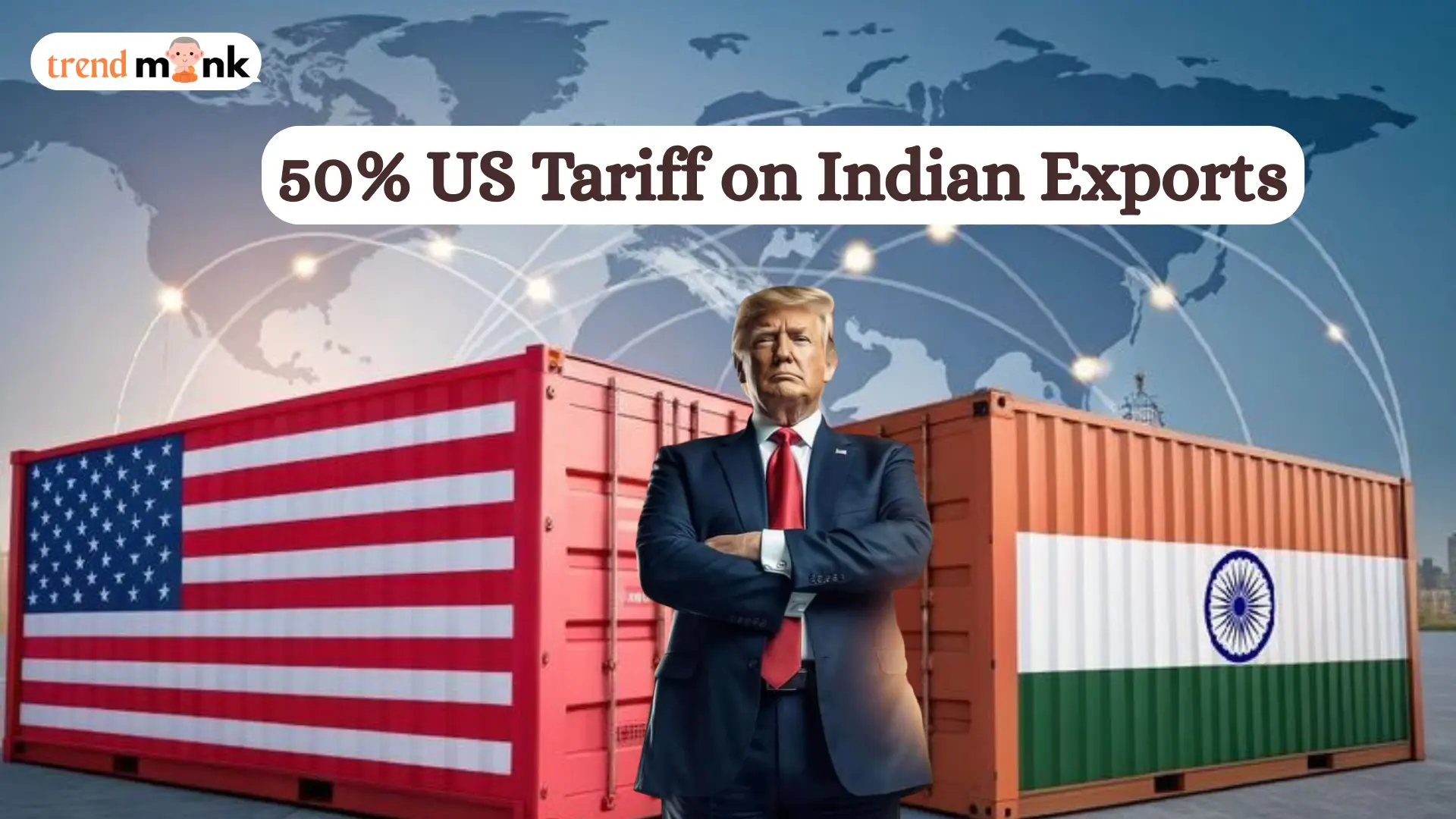Introduction
One of the biggest changes to India’s export-led growth since the 1980s is the US’s decision to impose a 50% duty on Indian goods through a tariff rate swap. These tariffs represent a period of instability and transition with an economy that is highly dependent on the US, as an export market and has an increasing middle-class, service and manufacturing sectors. This article is rich in concise, well-informed analyses and expert views that can help one understand this important trade event.
What Is the 50% US Tariff on Indian Exports?
On August 27, 2025, the US implemented a flat tariff of 50 percent on most of the imports it got in India- a trade of above 48 billion dollars. As the largest destination of Indian exports, the US holds close to 17 percent of India export goods- a sizable share, which is now the target of an escalating trade war.

Why Was the Tariff Imposed?
President Trump and the US government had justified the attachment of the tariffs describing the move as a direct repercussion to the fact that India was continuing to deal with the Russians on oil and other political mudslinging. This move is indicative to a more hardened attitude towards nations that continue trade with Russia, and this expansion is indicative of new trade protectionism as the world becomes more competitive. India, which had talked of the hope of exemption due to close US connections is now among the countries that experienced the highest US tariffs.
Economic Overview: India-US Trade Dynamics
The Scale of the Trade Relationship
The US and India have had a very strong trade relationship, which has evolved over many years. The US is the highest individual exporter of India, where it exports its goods and services worth almost $60 billion per year. American firms also depend on Indian manufacturers and IT services to their global networks of supply hence the tariff measure will cut both ways in both economies.
Sectors Most at Risk
The following Indian industries now face heightened vulnerability:
- Textiles and Apparel: The US is a good end-user of this in fashion and retailing.
- Pharmaceuticals: American generics supply most American homes.
- Gems and Jewellery: India products dominate a large portion of the US high end market.
- Making Goods & Auto Components: Absolutely vital to the international supply chains.
- Leather, Seafood, Agricultural Products: In states like West Bengal, they are booming employment factors.
Immediate Impact on Key Sectors
Industry estimates show that about two-thirds of India exports to the US are now subject to the new tariff thus rendering their products instantly uncompetitive with rivals in countries such as Thailand and Turkey, which remain at a lower tariff rate. Exporters are reporting:
- Unexpected fall in orders.
- Stalled production cycles, particularly within the labor intensive sectors.
- Shrinking profit margins and ever-increasing loan defaults.
Indian industry analysts said it has been worst in the labor-intensive sectors like textiles, gems, and jewelry in export hubs across Gujarat, Tamil Nadu, and West Bengal.
Broader Effects on India’s GDP and Job Market
The higher tariff affects more than just exports financially. Experts of Goldman Sachs predict a decline in the GDP growth below 6% in case the 50% tariff is maintained, as opposed to estimates of 6.5%. Experts reckon on a 0.3-0.5 percentage points growth rate lop-off, which is manifesting in cut-downs in factory output, an increase in the unemployment rate, and a slackened investor zeal. States that are export-driven like West Bengal are under greater pressure as exports of marine and leather have been disrupted.
Reactions from Policymakers and Industry Leaders
Indian leaders called the tariff a strategic shock and told their diplomats and businesses to respond as quickly as possible. Business executives stress the need to be flexible in business operations, stronger in compliance and make use of automation to go through these frequent disruptions. Indian authorities are in further discussions with high-relief status or phased reduction in tariffs and courting alternatives in trade agreements.
How Are Exporters Responding?
The exporters are becoming very strong at reconsidering the cost structure, rationalizing supply chains, and even giving a thought to geographic representation elsewhere in the world other than the US. It is being said as essential to adopt trade automation to a high level, real-time management of tariffs, and improved compliance-related procedures. There is also increased interest in value-added services and practice alliances on the part of many firms, as a means of ensuring competitiveness to stay audit-ready in international trade.
Strategies for Navigating Tariff Barriers
- Market Diversification
Indian exporting firms are turning toward the rest of the world like the EU, Southeast Asia, Africa, and Latin America as they attempt to regain the market share lost in the US. Some of the strategies that are being explored are fast tracking of trade agreements, investment in local warehouses and establishing assembly operations abroad.
- Value Chain Innovation
The development of partial competitiveness can be achieved with investments into R&D in order to enhance product quality, integration of digital tools to regulate tariffs, and provision of niche but high-value goods.
- Strengthening Local Supply Chains
Export losses may be countered by reducing dollar dependency, localization of sources of important inputs, and use of domestic demand to fill the gaps. Besides, the Indian policies that facilitate Make in India and Atmanirbhar Bharat are becoming increasingly relevant.
Global Perspective: How Do Tariffs Disrupt Supply Chains?
This sudden 50 percent tariff basically undercuts the plan of American companies to shift more production back into India in an attempt to escape Chinese domination. Lack of predictability in tariff environments is one of the most lucrative aspects that causes supply chain risk to most companies around the world and thus companies have to:
- Maintain flexible sourcing capabilities.
- Hold buffer inventories.
- Integrate technology for real-time risk assessment.
The main issue faced by India is how to show itself as a strong trade partner, to establish the best logistical system, and innovative thinking to build the global confidence back.
Frequently Asked Questions
What are the long-term risks of US tariffs for India?
A prolonged tariff will begrudge India its export competitiveness, halt employment generation processes and prevent the entry of FDI in areas that are dependent on US needs.
How can Indian exporters adapt to the new trade regime?
The market diversification, digitalisation, strong compliance behaviour, and integration of the value chain are imperative to adaptation.
What made the US raise tariffs on Indian goods?
The stated reason is the continued contact with Russia, which caused the policy shift on part of India.
Conclusion
India is in a critical orbit since its trade perspective is redefined by the 50 percent tariff instituted by the US. As menacing as the challenges may be, with billions of exports at stake, the loss of jobs, and cold foreign investment, the challenges also pose an immediate chance of transformation. Ex-porters, policy makers and entrepreneurs now need to nose toward alignment on resilience- innovation and global competitiveness in steering the Indian economy through this difficult phase.





